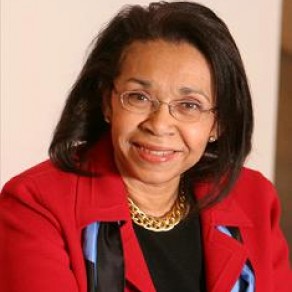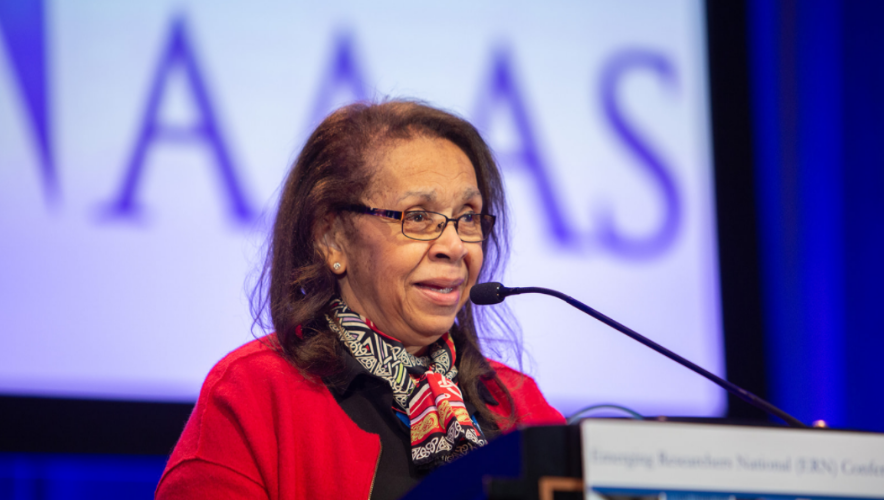Looking Forward by Looking Back: The Power of Adversity Featuring Dr. Shirley Malcom
NMSI |
February 3, 2022
The be ep heard around the world launched Dr. Malcom’s foray into science. She was 11 years old.
ep heard around the world launched Dr. Malcom’s foray into science. She was 11 years old.
On October 4, 1957, the Soviet Union successfully propelled the world’s first artificial satellite into orbit. Less than 23 inches in diameter, this small orb called Sputnik delivered a large dose of reality to the United States and its scientific community. Our nation was edged out by the Soviet Union, which sparked an awakening in science, technology, politics and education.
The other defining moment of Dr. Malcom’s young life came 10 months earlier when the parsonage of her family’s church, Bethel Baptist in Birmingham, Ala., was bombed on Christmas night in 1956.
“To this day, I still hear the bomb blast in my head,” Dr. Malcom says. “It’s not the kind of thing you forget. I’m a part of that history and it’s part of the context that I have. Civil rights and Sputnik are things that made me who I am and what I care about.”
The reality is we are products of our lived experiences, we are products of our times.
The Impact of Educational Inequity
Dr. Malcom started her education at Hudson School, a segregated school with inadequate facilities and a lack of Black teachers. Around the time when Sputnik launched, she moved to Lewis Elementary School where she started being taught real science and was captivated by the idea of something artificial orbiting around the earth.
“I then attended the very basic and utilitarian George Washington Carver High School,” Dr. Malcom says. “Meanwhile, Phillips High School was decked out with labs and facilities for students. I think there was perhaps an expectation that Phillips students would go on to become business leaders and scientists, but maybe Carver students wouldn’t.
“I tell people that they gave us our own high school in our own neighborhood so we could not challenge going to – or attempt to integrate with – a well-appointed school like Phillips,” Dr.Malcom explains. “In fact, Reverend Fred Shuttlesworth was viciously beaten when he tried to enroll a group of African-American students in 1957.”
During Dr. Malcom’s senior year at Carver in 1963, some of her classmates weren’t sure if they would graduate due to their participation in the Children’s March and subsequent expulsion by the all-white board of education. They were good students on their way to college and their future plans were now in jeopardy. Ultimately, after Dr. King went to federal court in Atlanta, they were reinstated and considered to be high school graduates.
A Rude Awakening
Going to the University of Washington was a major culture shock for Dr. Malcom, “I had real deficiencies because we didn’t have the same types of labs and chemicals Phillips High School did. I wasn’t as well prepared and I almost failed.”
After scoring 9/20 and 7/20 on her first two chemistry lab quizzes, she approached her TA – the only Black graduate student in the chemistry department – and explained that she wasn’t dumb, she had deficiencies because she had never even seen the equipment they were using at UW. Her high school simply wasn’t equipped to prepare her for college lab work.
Dr. Malcom finally persuaded the TA that she was “worth” helping and she scored 18/20 on her next quiz. Read that again. She had to persuade him to help her. Young Shirley Malcom needed to advocate for herself in a way that many privileged students will never experience or truly understand.

Photo Credit: Michael J. Colella for AAAS | Shirley Malcom speaks at the 2020 Emerging Researchers National Conference in Science, Technology, Engineering, and Mathematics in Washington, D.C.
A Powerful Paradigm Shift
Dr. Malcom was able to overcome adversity but not everyone can – or understands how.
“We put students in the position of making the adjustments to the higher education environment,” Dr. Malcom explains. “We need to stop trying to ‘fix’ girls, kids of color and other students – we need to fix the institutions that are supposed to serve them.”
In fact, it’s not the girls or kids of color at all. Interest in STEM and medical fields doesn’t vary by gender or race when students approach higher education. Students from all different backgrounds and groups head into higher learning with comparable levels of interest. But graduation rates and employment in those fields are woefully disparate.
According to a Pew Research Center analysis of federal employment and education data released in 2021, Black and Hispanic adults are less likely to earn degrees in STEM compare to other degree fields, and they continue to make up a lower share of STEM graduates relative to their share of the adult population.
This can only be improved if we change our mindset. Instead of expecting students from all backgrounds to conform to an inflexible higher education structure, institutions should prepare themselves to welcome and support a more diverse student population.
Dr. Malcom explains that although the people and groups have tried to move the needle in diversifying the science community with programs, ideas and other efforts, those little things aren’t adding up to the tsunami of transformation we need. Instead, we need to ask ourselves:
-
What does re-imagining higher education look like?
-
How do we change our mindset of focusing on milestones you make or miss?
-
How do we move away from relying only on having enough personal grit to make it to the next level?
-
How do we drive toward people with a stronger focus on the students themselves and the communities they come from?
We start by identifying what assets our students have and build on those by investing our time into understanding the context of students’ lives. We help them connect their lived experiences with expansive opportunities and create culturally relevant experiences and learning models. We help them see STEM in their daily lives and show them it’s part of their attainable future.
In order to address this much-needed systemic overhaul in higher education, Dr. Malcom is leading the SEA Change initiative at the American Association for the Advancement of Science. This effort is focused on making sure that when students are ready for college, the colleges and universities are ready for them. The goal is to provide clear roadways, on-ramps and navigational aids to help students take what institutions have to offer and turn that education into careers.
In addition to the work Dr. Malcom is doing through SEA Change, she explains that the College Readiness Program of the National Math and Science Initiative has a two-fold approach to overcoming the barriers to equitable opportunities in STEM education.
First, CRP guides and supports educators as they address the challenges of college preparation in the 21st century, especially among underrepresented groups. Second, the program equips students with the knowledge and skills needed to navigate the rigors of higher education, especially in the STEM fields.
Forging a New Path Forward
Of course, even with an interest in STEM, getting into college is a challenge for many students. One of those barriers is the ability to score well on exams like the ACT® and SAT®. In a serendipitous turn of events, those testing requirements were eliminated for the 2020-2021 and 2021-2022 school years due to the COVID-19 pandemic.
Dr. Malcom says that this gives us an opportunity to see if students who would have been kept out of certain schools or areas of study due to standardized testing are now empowered to succeed. With more than half of colleges and universities already extending that stance for 2022-2023, it increases the length of this unintended experiment, giving us more time to assess the impact, value and fairness of these exams.
But that is only one of many lessons learned during the pandemic. We also pondered other topics and social issues including:
-
Navigating a virtual environment
-
Connecting to students and their lived experiences
-
Becoming more reflective in our teaching
-
Wondering if our systems are working equitably for all
-
Recognizing health disparities for people of color
-
Confronting systemic racism
-
Discovering the deep divide in access to technology
Similar to Dr. Malcom’s experience at the intersection of science and civil rights in the 1950s, we are now in the midst of our own reckoning as we look at the science of COVID-19 and confront the systemic racism that many people still deny.
Dr. Shirley Malcom shared her personal story of how looking back helps her look forward. Now it’s up to us to provide students with the structure and opportunities that support STEM achievement in higher education. This will enable them to contribute to an economy that is defined by science and technology, and driven by innovation to solve the challenges that we face – as a people and as a planet.
About Shirley Malcom Ph.D
In addition to serving as the National Math and Science Initiative’s chairwoman, Dr. Shirley Malcolm is Senior Advisor to the CEO and Director of the SEA Change initiative at AAAS. She works to improve the quality and increase access to education and careers in STEM fields as well as to enhance public science literacy. Malcom, a native of Birmingham, Ala., received her Ph.D. in ecology from The Pennsylvania State University, masters in zoology from UCLA and bachelor’s with distinction in zoology from the University of Washington. She holds 16 honorary degrees. In 2003, Dr. Malcom received the Public Welfare Medal of the National Academy of Sciences, the highest award given by the Academy. Learn more about Dr. Malcom here.
This article is based on Dr. Malcom's keynote speech at NMSI's 2021 Summer Series.